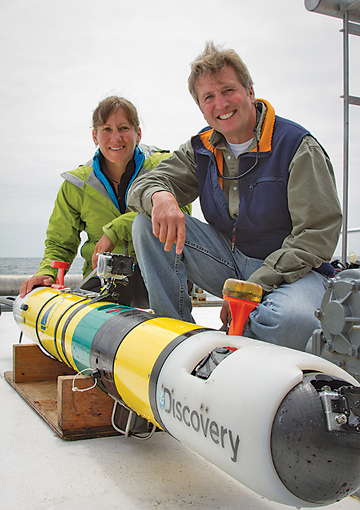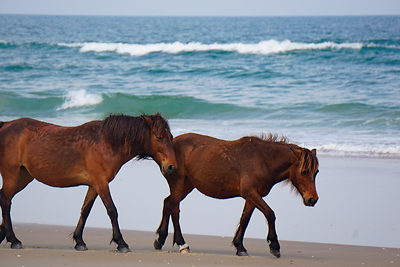Back in 2011, a 6-year-old girl – playing on a summer day in the Outer Banks with her family – was bitten by (best guess) a black-finned shark while standing in a foot-and-a-half of water with her vigilant mom close by. A Greenville, North Carolina, trauma center’s helicopter airlifted our heroine to safety. She made the world laugh by announcing in her elf-voice, “I like dolphins waaay better.” The little champ recovered beautifully!
In 2001, a young boy, bitten about fifty yards from the shore in Sandbridge Beach, Virginia, died after an extremely rare shark attack. In 2015, eight people experienced shark bites in the Outer Banks. Last summer, six great whites – dining on a whale carcass – closed three Cape Cod beaches.
Not Your Imagination
Shark encounters are up. These toothy creatures are trending, and the news is both reason to celebrate and cause to continue to scan the horizon for a fin – as most of us have done for years in our post-JAWS world.

Having studied marine predators for decades, shark biologists are quick to remind us that we’re statistically more likely to die hunting Pokémon than to be bothered by a shark.
Shark experts inhabit a small world, meaning they know each other, share research, (likely) trade Land Shark and Sharknado jokes. I spoke with East Coast expert, Greg Skomal, senior marine fisheries biologist and head shark guy at Massachusetts Division of Marine Fisheries, and Chris Lowe, professor of marine biology and director of the Shark Lab at Cal State, Long Beach. Both emphasize that while much about sharks remains murky, shark experts have discovered new facts – and dispelled many of the old ones – since that iconic da-dum, da-dum, da-dum music first washed over our eardrums.
Here’s the scoop on keeping you and your family shark-smart:
1. Awesome with a Bit of Uh-Oh Shark populations are definitely on the rise. “For at least fifty years, some shark populations were overfished. About twenty years ago, we put in protections for sharks because we recognized their populations were overhunted,” says Lowe. “That protection is working, and shark populations are coming back. More people are going in the water than ever before, and when you’re putting sharks and people side-by-side, you’re increasing the chances of them interacting.”
The lesson Lowe wants bolded and underlined? “We have two generations of Americans that have basically had an easy time with the ocean. They’ve had fun without worrying about predators. Well, that’s changed, and it’s taken decades to occur. With more people in the water and shark populations coming back, the rate of encounters is going up.”
2. Happy Fact with a Strong To-Don’t Humans aren’t a box of chocolates. “If sharks evolved – over millions of years – to eat land animals, we would see hundreds of thousands of attacks every year,” says Skomal. “An adult white shark’s meal of choice is the high-blubber content of seals or sea lions. In comparison, we look skeletal.” Your takeaway? Don’t ever swim near seals or sea lion colonies.
3. Tired Myth Sharks are crafty villains. The movies love the lone shark terrorizing a beach community, or in the case of The Shallows, a person. Yet “there’s just no evidence of a rogue shark,” says Lowe. “People are often getting bitten, but not consumed. It’s possible that sharks bite for defensive reasons.”

Sharks may, in fact, be scaredy cats. “The majority of people who are bitten never see the shark,” says Lowe. “It could be that the person is getting closer and closer to the shark, who is saying, ‘You’re in my space, back off!’ It’s exhibiting all sorts of body language that we can’t even interpret. And then the shark finally says, ‘Okay, you’re too close.’ It rushes to defend itself [by biting] and the person takes off. Situation resolved.”
To avoid sharks that may feel threatened, swim in highly populated beaches. “It could be,” says Lowe, “that people are noisy and chase away the shark’s prey. We know that sharks aren’t biting people because they consider us food. If sharks considered people a possible meal, heavily populated beaches would be a Costco for sharks.”
4. Pale Palms Theory Palms and bottoms of our feet flailing about in the surf might look like fish in a school. Lowe explains that, “the shark rushes in thinking it has found prey and bites somebody’s foot
or hand. Those bites could be predation-related because the person’s pale palm is mistaken as a darting fish. In most cases, the size of the bite marks are not large.”
5. Interesting Sharks are the bloodhounds of the sea. As anyone who watched Bruce the Shark in Nemo knows sharks are attracted to the smell of blood. While sharks are known to have very sensitive noses, they likely don’t have the ability to “detect one drop of blood in a million drops of water” from a mile away as has been trumpeted for years. “Sharks have great olfactory, auditory, and visual abilities to locate prey,” explains Skomal. “When they are close enough, within a yard, they can also detect the low levels of electricity generated by living prey using their electrosensory system, which is how a shark can find a sting ray under a blanket of sand.”
So, a small scratch on your leg won’t necessarily draw sharks to the area from miles away,” says Skomal. And that old idea that sharks don’t see well? Rest assured, their eyesight is fine, too.
6. Never Ever, Ever A type of stinky, bloody bait that fishermen throw into the water to attract fish and sharks is called chum – ground up fish. “While fishing alone may not draw too much shark attention, some fishers use chum while fishing off piers or boats,” says Lowe. This combo can make swimmers and fishers a dangerous cocktail.” And the expert adds that if you spy a flock of birds dive bombing the water, assume that sharks will also be attracted to whatever is so engrossing to the birds.
7. Again, Never Don’t swim near river mouths. Rivers pick up dead land animals from various spots along their route and deposit them into the ocean. Guess who’s waiting for the lunch wagon to produce? “Statistically,” says Lowe, “we see more people being bitten in these areas (at the river mouth) than if they went two or three miles down the coast.”
8. A Good Idea Leave the bling at home. “Bait fish tend to be sparkly,” says Skomal. “Wearing jewelry that glitters and shines could confuse a shark who thinks that the glint is food.” (King to the pale palm theory.)
9. No Idea It’s long been said that because dogs swim in a jerky motion, a shark will interpret the dog paddle as an animal in trouble. Since few of us swim in the ocean with our dogs, shark experts haven’t turned their scientific-beam onto this theory.
10. Fact: Lifeguards are Your Friends Visitors don’t often converse with the guardians of the beach until there’s a problem. Before you start swimming in the ocean, strike up a conversation with the lifeguard and get the scoop on not only the shark activity, but also what’s happening with the jelly fish, stingrays, and rip tides. “Know your beach,” Lowe says. “Talk to the lifeguards. For example, if there are dead animals floating around, you don’t want to be in the water.”
Lifeguards do more than sit on tall chairs counting our heads in the sea. When word gets out that a shark might be in the vicinity, they hop a jet ski to determine whether the spotted fin (or form) is a dolphin, sea lion, or shark. In the near future, Lowe says lifeguards might have drones and robots at the ready to detect what is happening in the water. “When a lifeguard is in a boat or a jet ski, they’re often not high enough to actually see well,” says Lowe. “But with a drone, a lifeguard can fly that out (and get a better view). We’re developing these tools right now.”
Why Does Our Planet Need Sharks?
Those great whites dining on the whale last year in Massachusetts? They’re only doing what they’ve done for 450 million years: cleaning up the ocean. We finally get that we need this apex predator to keep our oceans tidy.
“But sharks are also active predators and feed on live animals,” says Skomal. “We need all parts of the food web, and these top predators play an enormous role in keeping the oceans in balance.”
Across the planet, today’s shark-biologists continue to devote their lives to studying the shark and, as their knowledge increases, they’re sharing intel with us so that marine life and ocean-lovers can live safely side-by-side.
Beach Destinations for Your RVA Family
Every one of these beaches is family-wonderful and about a morning’s drive from Richmond.

Carova, Outer Banks (4 hours)
Ready for adventure? At the most northern neck of the Outer Banks is Carova, best described as a cluster of neighborhoods north of NC 12 in Corolla and accessible only by 4×4 vehicle. It’s a dazzling strip of coastal land that’s home to a wondrous surprise: Carova Beach has been a haven for wild horses for centuries. Amazing, right? The Wild Horse Adventure folk will drive you and the family (even little ones in car seats) in an open-air hummer into exclusive beach areas to spot these wild mustangs. It’s illegal to get within fifty feet of these protected treasures, but cameras are smiled upon. (wildhorsetour.com)
Indulgence or a Smart Stay: Carova is blissfully free of hotels, motels, boutiques, amusement parks, and the like, but you will find cottages at various price points. The neighborhoods are also free of paved roads. A stay in Carova means accessing your cottage using a 4-wheel drive vehicle only. When you use Vacation Rental by Owner (VRBO.com), you choose how fancy – or informal – your Carova vacation will be.
A large waterfront cottage minutes from the beach provides three stories of cozy rooms with views and sleeps ten for $400 a night. A super clean, no-frills cottage with a wrap-around porch – often visited by moseying wild horses – sleeps five for $179 a night.
Best Corova Tip: Book your cottage yesterday – they fill at lightning-speed.

Virginia Beach, Virginia (2 hours)
Remembering Virginia Beach from 20-plus years back? It’s time you had an update.
As we all know, hurricanes roared through Virginia Beach several times, and the powers-that-be decided to flow lots of dough into the area to create a vacation destination for families (with $15 million more every three years). Result? A glittering beach strip that screams summer (but other seasons rock, too) with an upscale boardwalk including two parallel paved paths: one for walking, and one for biking and skating. The beach is ideal for families with its clean bathrooms, lifeguards, and wholesome party atmosphere. Parents of the little ones might not love the semi-rough waves here, so the main Virginia Beach strip may be best for kids over ten. For smaller kids, consider Chicks Beach – technically Chesapeake Beach –- with sleepy waves, fine sand, and overhead bridges that assure great shade.
Off the Beach: Located in Norfolk, Nauticus is about twenty minutes from Virginia Beach, making it a perfect outing for a half-day away from the elements (think rain or sunburn). This fascinating museum effectively combines aspects of marine, maritime, and naval life. You’ll take in weapons, a real battleship, artifacts, a wind simulator, and animals in the Shark Touch and Horseshoe Crab Cove exhibits. My 10-year-old sons say, “Nauticus is very, very cool.” Mom says, “Major worth it.” Plus, it’s part of the Science Museum of Virginia’s reciprocal membership network. That means if you bring your Science Museum family membership, two adults and four children get into Nauticus free.
Indulgence: Hilton Virginia Beach Oceanfront sits on the beach and is wreathed in boardwalk-excitement. The VB Hilton boasts rooftop pools, gorgeous interiors, excellent parking, and luxuries galore. (Downside for families: there are no double/queen rooms, only double/full-size.)
Smart Stay: The Residence Inn Virginia Beach Oceanfront is all about location (sitting next to the Hilton), minus the price tag. This all-suites property delivers spectacular views from oceanfront balconies, a full kitchen, a fun indoor pool, and direct beach access. Room rates include free WiFi, hot breakfast, guest laundry, and parking.
Delish: Beach Bully (awesome BBQ), Big Sam’s Grill and Raw Bar (casual; big breakfasts and lunches), Doc Taylor’s (Best. Breakfast. Ever.), Tad’s Deli (sandwiches for picnics and fussy-eaters – closes at six o’clock), Il Giardino (awesome Italian fare and kids are welcome).

Rehoboth Beach, Delaware (5 hours)
Plunk Mayberry on a pristine swath of sand, and you have Rehoboth. Somebody who loves the place must have stopped the developers from plowing this beautiful area and layering the strip in fast food this-and-that. You won’t find many chain hotels either. The beach community features an array of fun, including an old-timey boardwalk with modern amenities (faucets for cleaning tootsies and bathrooms), a small amusement park, live bandstand tunes, rental bikes, and boardwalk treats (fudge, great pizza, and frozen custard). The quaint town of Rehoboth brims with pretty cottages, well-kept lawns, art galleries, cool shopping, great dining, and welcoming hotels for every budget.
Indulgence: The Bellmoor Inn & Spa, cozy, yet upscale, serves phenomenal breakfast and afternoon tea – and is an easy 2-block walk to the waves and shops. Inviting library, two relaxing outdoor pools, and a board game room serve to remind families: vacations and technology? Just, no.
Smart Deal: The Holiday Inn Express Rehoboth Beach delivers clean rooms with a mini-fridge and a microwave, free parking, a free hot buffet breakfast, free WiFi, with a town shuttle stop right behind the property. The hotel is a mile from the beach (not walkable, but your wallet will love you). The hotel is a two-minute walk to Fresh Market, just over a half-mile to the Tanger Outlets, and two miles to Walmart.
Delish: The Greenman Juice Bar & Bistro in Rehoboth will keep your carnivore and vegetarian happy. (Tip: Dine without the crowd by arriving before or after lunch – the place is popular. They’re open eight to four every day except Tuesdays.) For great pizza, check out Nicola’s in Rehoboth. A toy train circles overhead in this sit-down eatery, and there are crayons for the younger set.

Kill Devil Hills, Outer Banks (3 hours)
When we first moved to Richmond, a friend invited me and the kids to join her family on a trip to the Outer Banks hamlet of Kill Devil Hills. Having never been to OBX, I was thrilled. Seven years later, I can still picture our youngsters building sand castles, clowning together on the beach, her daughter flying a kite, and all four of the kids charging into the surf. Magical memories.
And the history in Kill Devil Hills just blew my California-brain! The Wright Brothers’ twelve seconds in air happened (ever so slightly) above Kill Devil Hills. Today, a memorial and museum sit on the spot commemorating the December 1903 flight. We visited the memorial on a roasting day. My boys only wanted to get back to the beach, but giddy-me kept saying, “But this is the Wright brothers! Rally, people!”
Indulgence: You won’t find a five-star hotel in Kill Devil Hills, so for luxury accommodations head to VRBO.com to find large cottages that sleep fourteen – some with a pool for $600 a night.
Smart Stay: Vacationing on the beach without the price tag? We’re not talking Ritz-Carlton, but the Days Inn Kill Devil Hills Oceanfront is on the beach and comes with a mini-fridge and a microwave in clean rooms. The property also has suites, and some units have kitchens. Complimentary amenities include hot breakfast, parking, and WiFi. The property sits 0.5 miles from the Wright Brothers Memorial and has its own pool (seasonal).
Before You Go!
Four Ways to Learn More About the Ocean
 1. After four decades of diving, Peter Benchley, author of JAWS, wanted to share the wonders of the deep with us and wrote Shark Life: True Stories About Sharks and the Sea. Every family should read this gem together before every trip to the beach.
1. After four decades of diving, Peter Benchley, author of JAWS, wanted to share the wonders of the deep with us and wrote Shark Life: True Stories About Sharks and the Sea. Every family should read this gem together before every trip to the beach.
2. You know the Santa tracking site called NORAD? Follow tagged sharks in real time along the East Coast at ocearch.org.
3. Or visit atlanticwhiteshark.com to download the Sharktivity app that lets users see great whites along the Atlantic Coast in real time.
4. We’re terrified of sharks, but don’t give much thought to riptides. But guess which one we’re more likely to face? Before your vacation, teach the kids how to spot riptides and how to escape the deadly current. Start at ripcurrents.com, an education resource that’s dedicated to reducing the number of rip-current drownings at beaches around the world.




